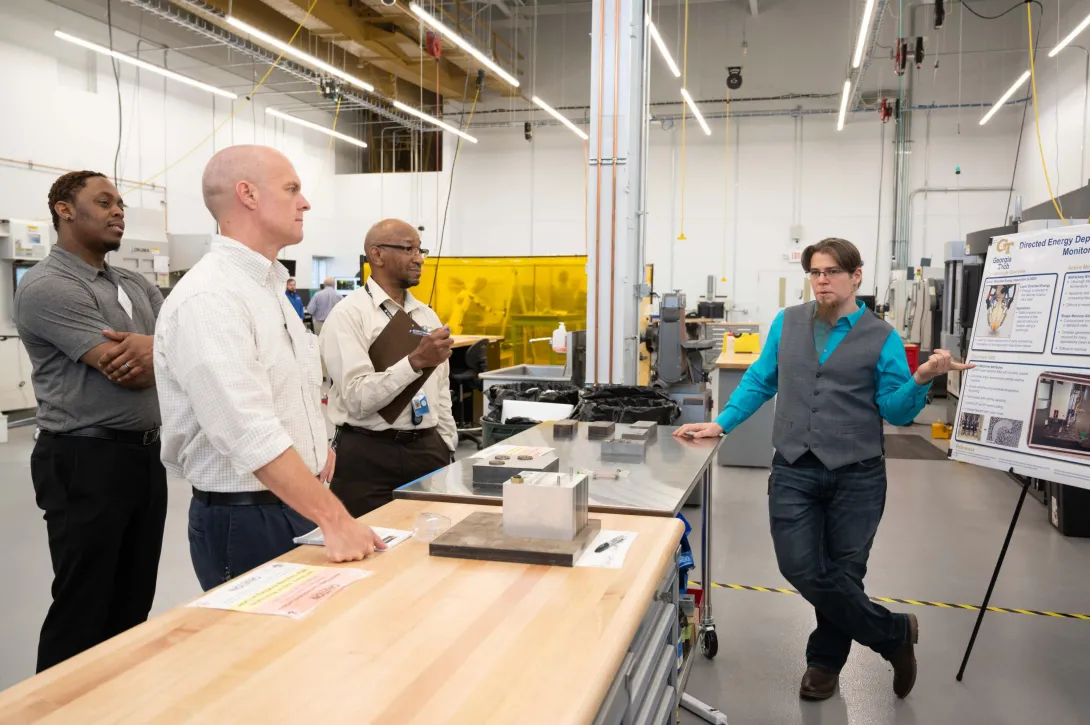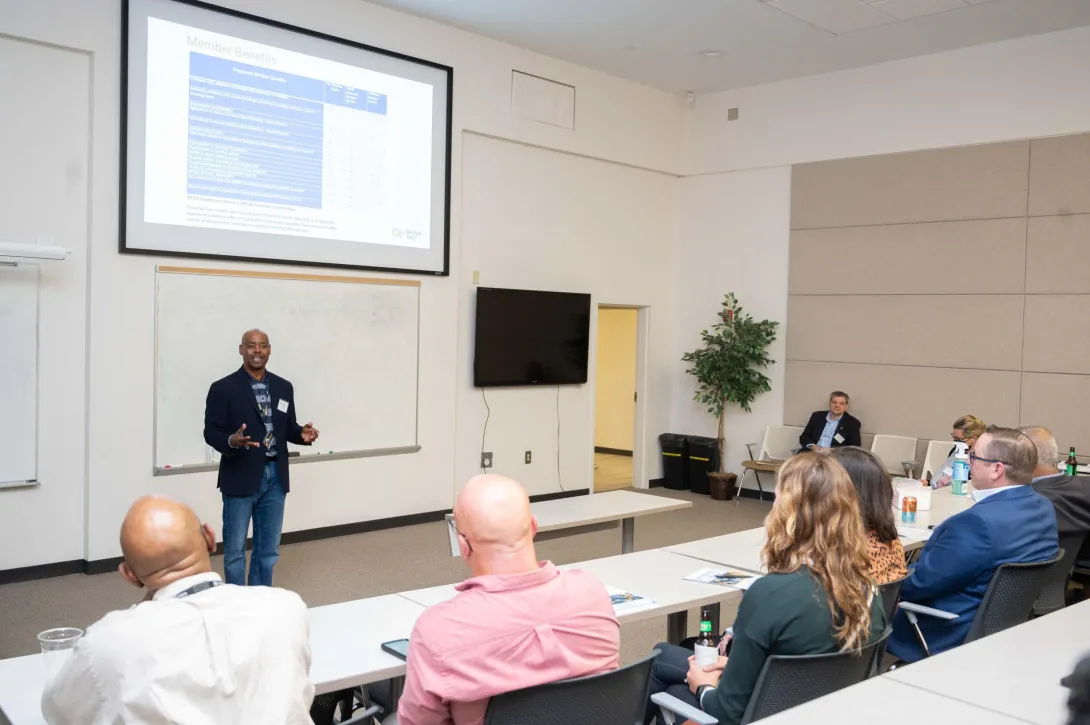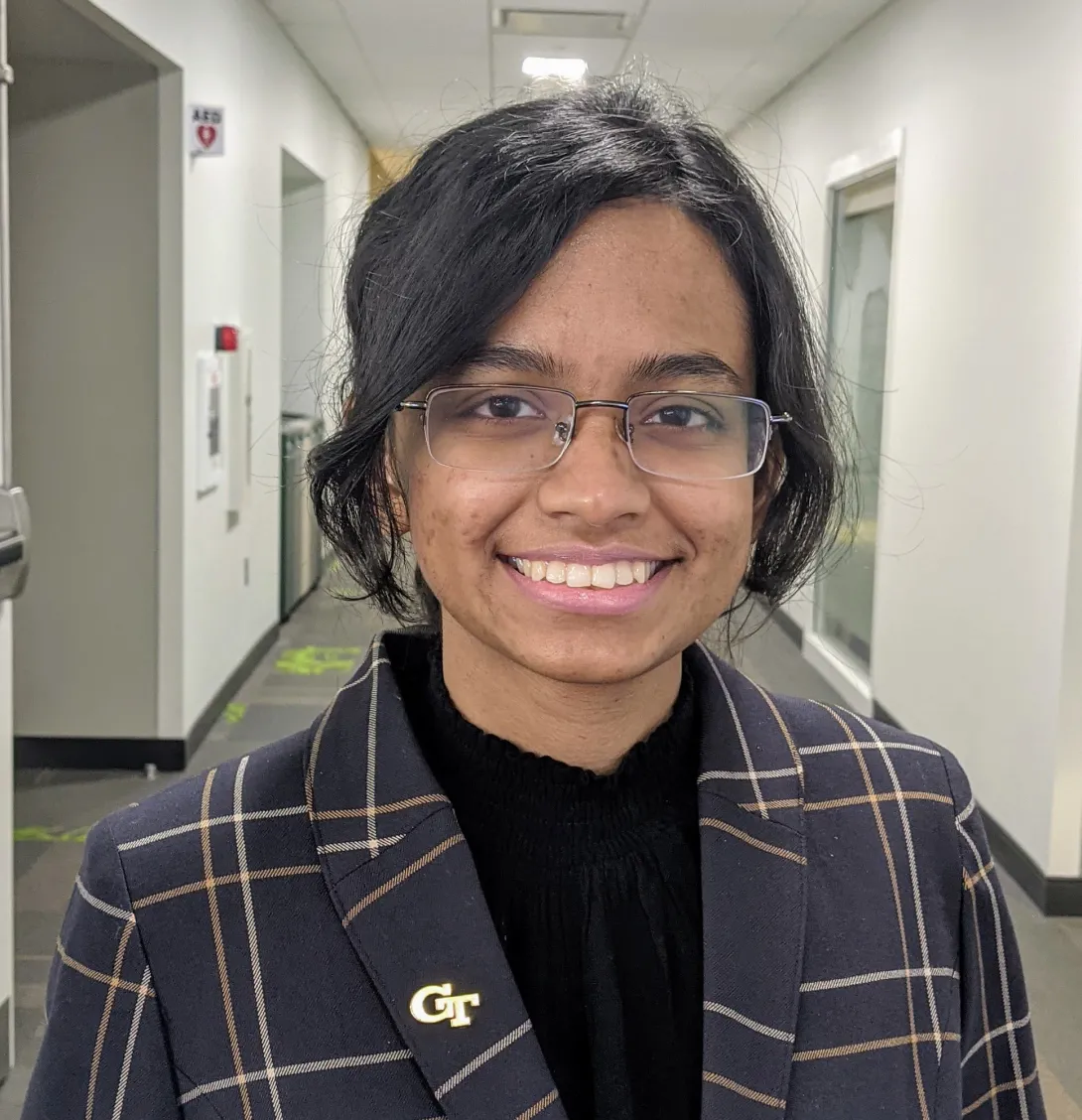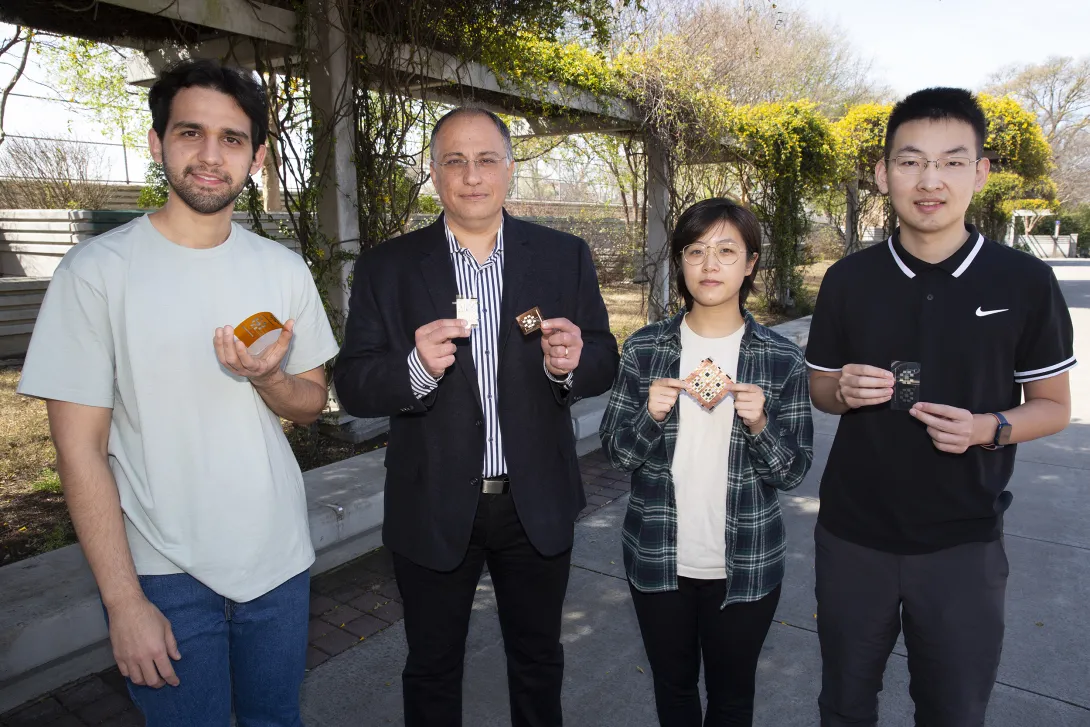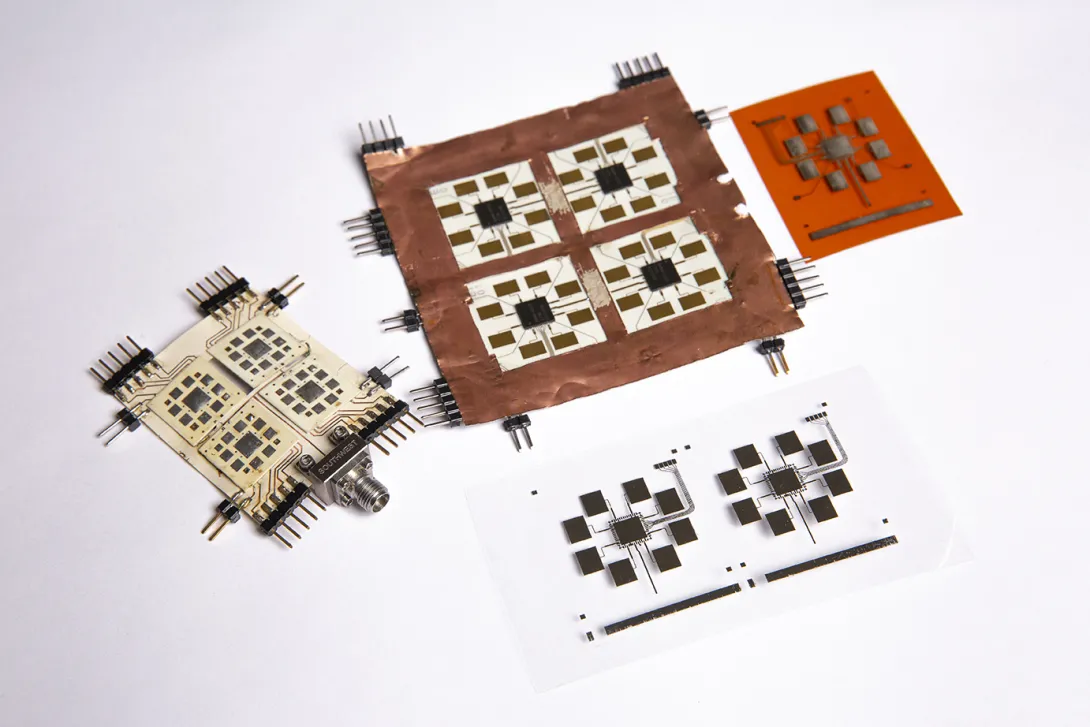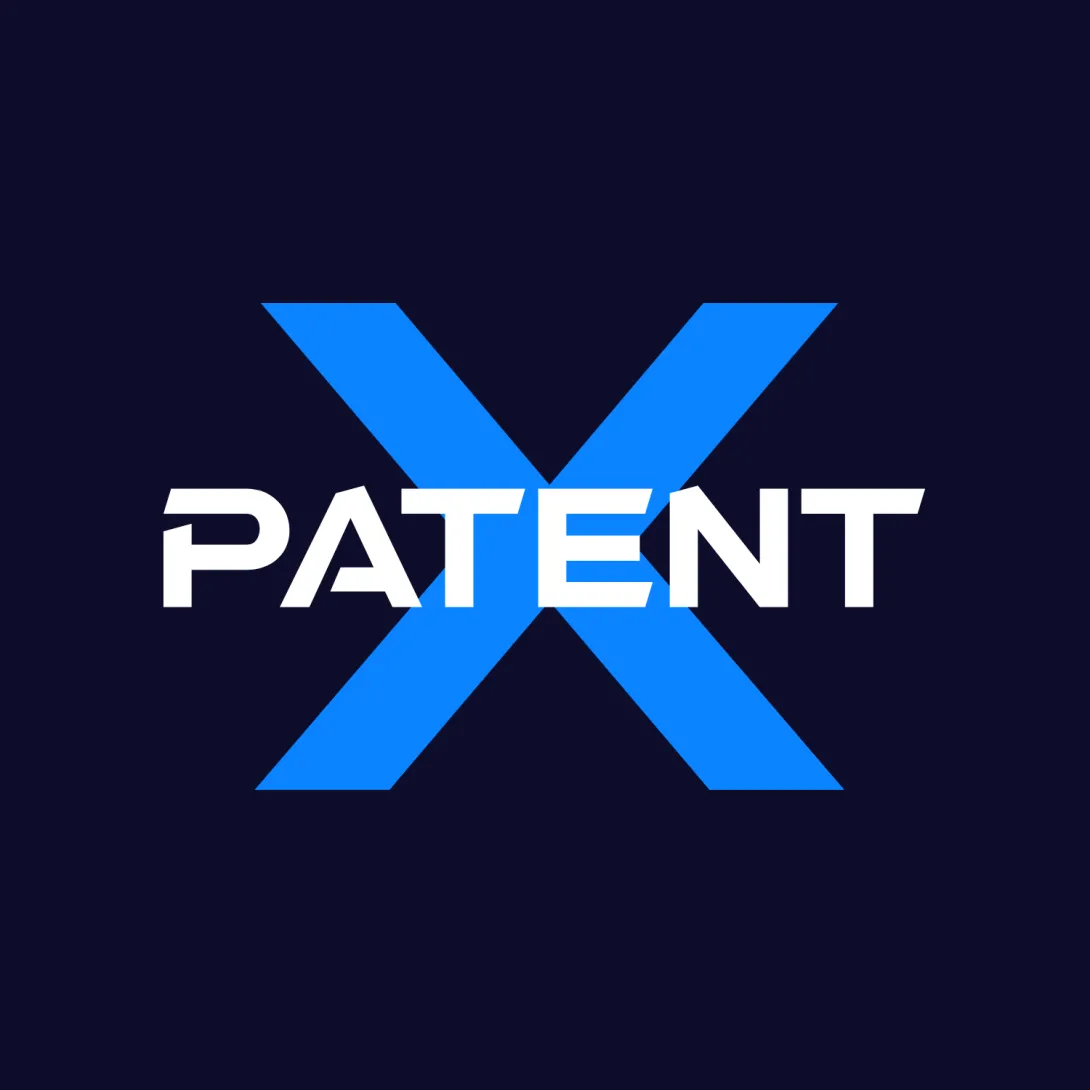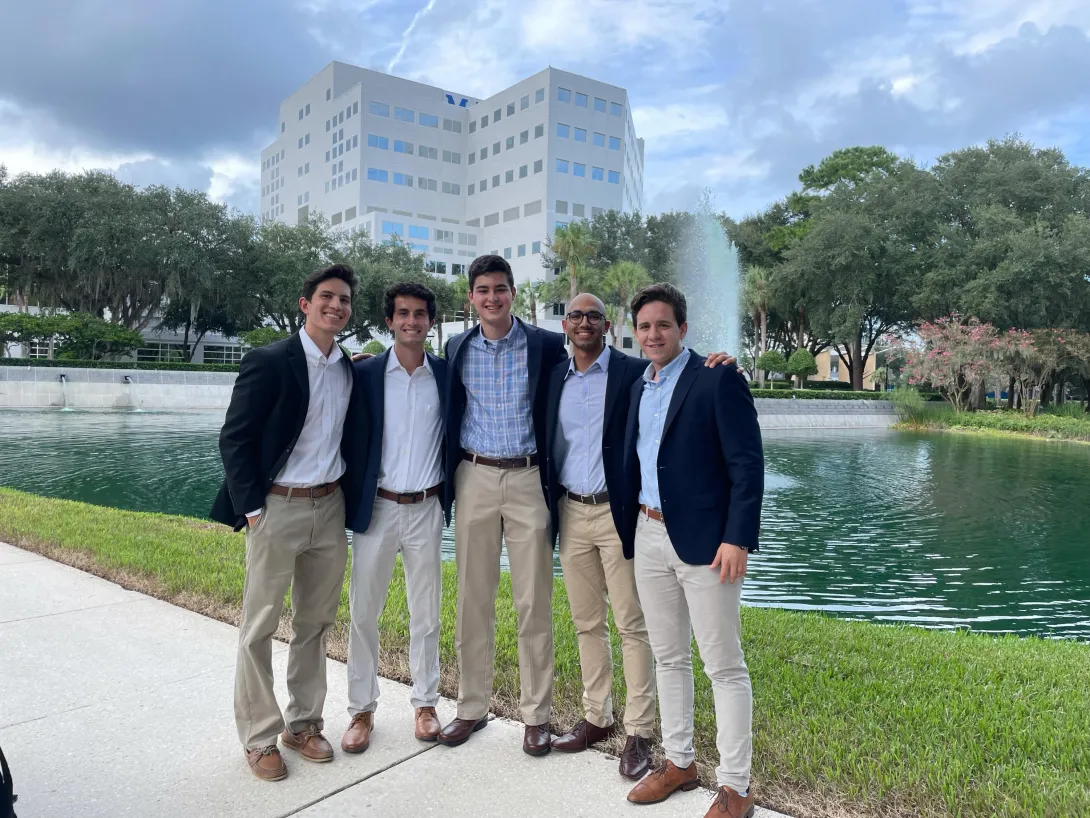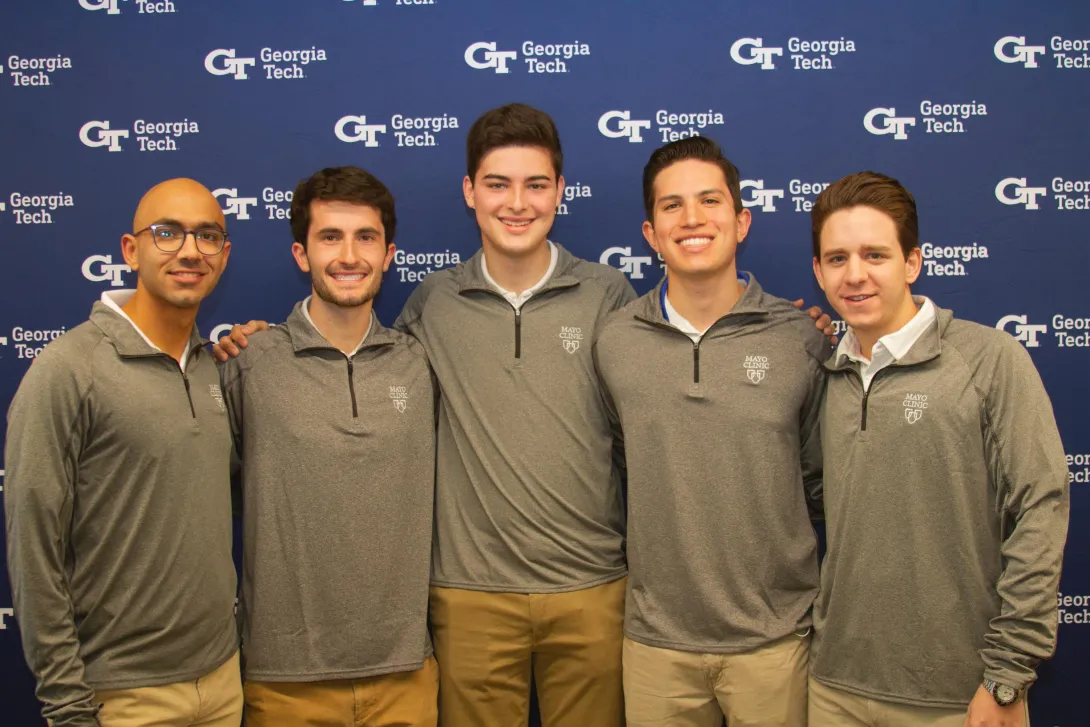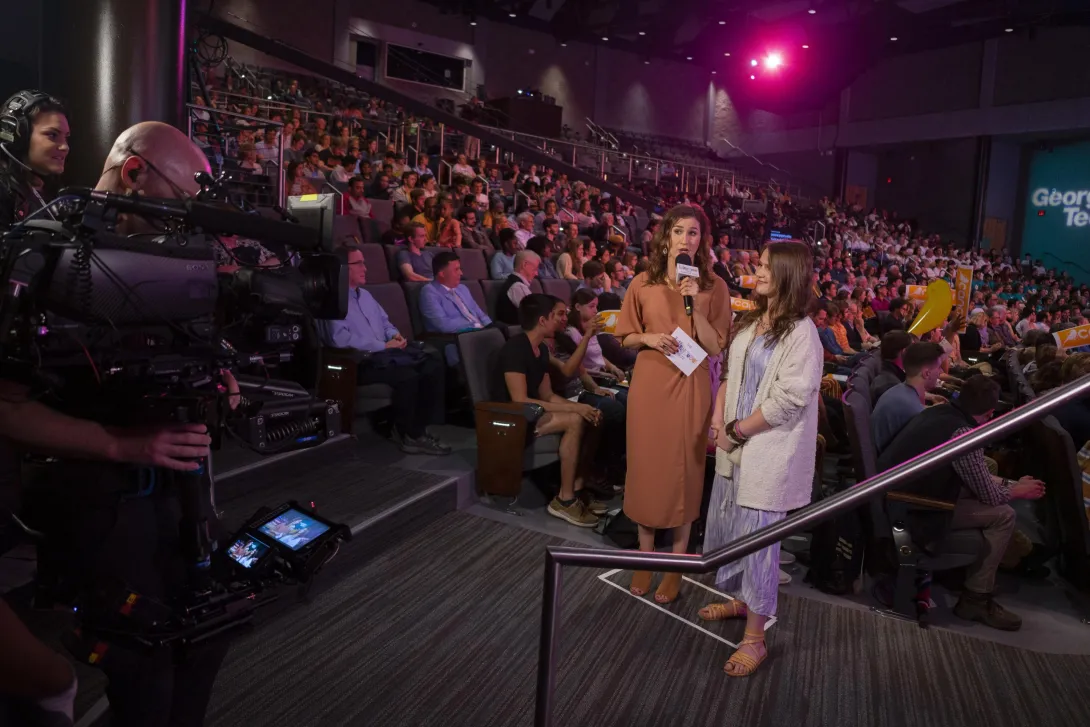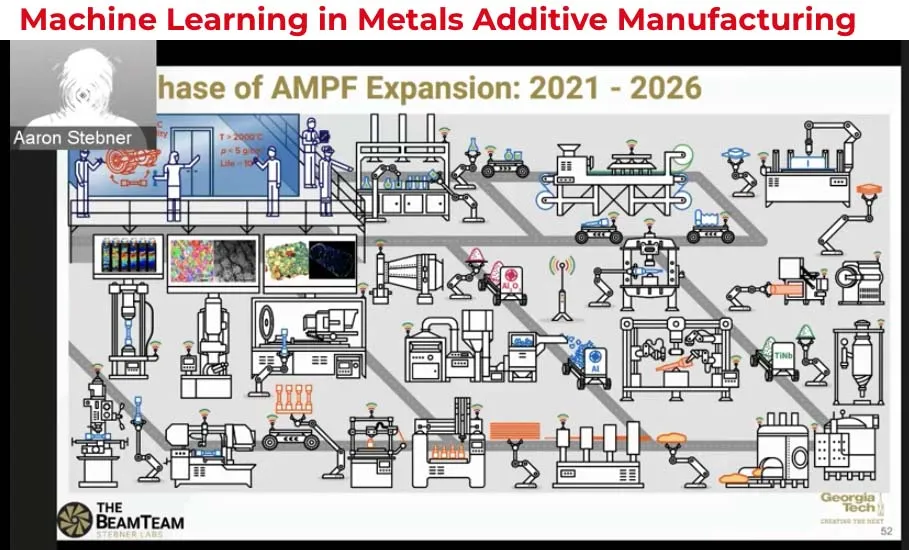Apr. 15, 2022
The Georgia Tech Manufacturing Institute (GTMI) hosted an open house to celebrate the launch of the Georgia Manufacturing 4.0 Consortium. The event took place inside Georgia Tech’s Advanced Manufacturing Pilot Facility (AMPF) on April 14, 2022. The 20,000 square foot research and development facility is located on Georgia Tech’s campus.
AMPF open house activities included an informational session, tour, equipment demos, and networking reception. Attendees from more than 45 companies learned how to engage with the Georgia manufacturing community through workforce development programs, technology pilot programs, and research activities to innovate and accelerate secure integration of Industry 4.0 technologies into Georgia manufacturing.
The newly created Georgia 4.0 Manufacturing Consortium is an industry-academia-government consortium that advances and deploys manufacturing technologies into the market. By leveraging the latest in manufacturing developments and technologies, consortium members have unique opportunities to compete more effectively to become global leaders.
“Georgia Tech’s AMPF provides a world-leading proving grounds for developing, de-risking, and piloting new manufacturing technologies to make them ready for commercial adoption,” said Aaron Stebner, associate professor in the Woodruff School and Mechanical Engineering, and School of Materials Science and Engineering. “AMPF was enabled through Georgia Tech’s manufacturing research partnerships with Boeing and Delta. In it’s first two years, the mission has expanded to include collaboration with more than a dozen companies. Establishing the Georgia Manufacturing 4.0 Consortium provides a vehicle to include dozens more companies in each of the future years, with emphasis on growing the participation of small businesses supported through grant subsidies.”
The consortium will conduct research, offer workforce training, provide small manufacturers with the ability to use advanced manufacturing tools, gain information to drive product and material changeovers, innovate new products, provide economic diversification, accelerate product development cycles, and adopt Industry 4.0 technologies.
Georgia Tech’s AMPF was created by a $3 million gift from the Delta Air Lines Foundation and was intentionally designed as a flexible space that can house future manufacturing innovation projects of almost all types, from additive/hybrid manufacturing to composites, digital manufacturing/industry 4.0, and industrial robotics. Current AMPF industry partners range from aerospace and automotive companies to materials manufacturing companies.
The AMPF is a flagship component of the Georgia Tech Manufacturing Institute and is a special, reconfigurable R&D high bay manufacturing facility where companies work alongside researchers and students to take early-stage concepts from idea to reality. With each new project and innovation, AMPF is where the factory of the future is being envisioned and created.
The Georgia 4.0 Manufacturing Consortium was created with funding from the Department of Defense (DOD) Office of Local Defense Community Cooperation. This DOD office helps states and communities strengthen critical relationships with Department of Defense’s assets and installations. Small businesses (less than 100 employees) will be able to receive discounted consortium membership rates as a result of this DOD grant funding. While DOD funded the consortium, companies outside of the defense industry are also welcome to be part of the consortium.
“Creating a valuable advanced manufacturing pilot facility and holding this industry-focused open house has been a long-term key goal. Our new governance structure is allowing AMPF to incorporate industry partners as members of AMPF along with the establishment of this new consortium for small and medium companies to join at a discounted rate,” said George White, director for strategic partnerships in the Office of the Vice President for Interdisciplinary Research.
“I also want to thank Ben Wang, executive director of the Georgia Tech Manufacturing Institute, for his strong, unwavering support to build AMPF. With Ben’s support, we’ve been able to build a world-class R&D pilot facility to advance manufacturing technology and solve problems for a variety of industry partners over many years—and will continue to do so for many other industry partners.”
Companies interested in joining the Georgia 4.0 Manufacturing Consortium can contact George White or Aaron Stebner at Georgia Tech.
News Contact
Walter Rich
Apr. 07, 2022
The SecureAmerica Institute (SAI) and the Advanced Robotics for Manufacturing (ARM) Institute are partnering with Georgia Tech to investigate how robotics and automation in manufacturing can enhance the resiliency, flexibility, and competitiveness of U.S. industrial base supply chains, thanks to a $5 million grant award from the U.S. Department of Commerce’s National Institute of Standards and Technology (NIST).
The project plans to create the Robotics and Automation Decision Framework for Agility and Resilience (RADAR). This framework will allow small and medium-sized manufacturers (SMMs) to systemically evaluate the cost-to-benefit ratio of integrating robotics and automation for aiding the response to supply chain disruptions due to public health crises like COVID-19 and additional economic threats.
“The RADAR end-to-end supply chain framework encompasses macro-scale and micro-scale modeling, along with physical demonstration, by bringing together interdisciplinary capabilities of elite partners from SAI and ARM — including the Texas Manufacturing Assistance Center, Georgia Institute of Technology, General Electric, Deloitte, and Morgan State University — to serve the requirements set by NIST,” said Eleftherios Lakovou, Ph.D., SAI’s manufacturing supply chain director and principal investigator on the project.
He sees the award as an exciting and potent validation of the unique footprint SAI has established and a way for the institute to provide innovative solutions to national priorities.
“The project is particularly valuable because it empowers SMMs, who form the backbone of the nation’s industrial base,” Lakovou continued. “Small manufacturers often lack the scale and human capital needed to increase their use of automation and robotics to position themselves favorably in the sophisticated, next-generation, cost-competitive, agile and resilient supply chains of America’s future.”
“We are delighted to work with the team at the SecureAmerica Institute on this important project,” said Arnie Kravitz, chief innovation officer at the ARM Institute. “Our work will help smaller manufacturers make better decisions in the face of the current and future pandemics.”
The Georgia Tech team will contribute to this initiative by providing already developed and validated supply chain simulation software and extending it to stress test supply chains so that small manufacturers can be better informed of what risks their supply chains might face, how these risks can be mitigated, and what role robotics and automation can play as a source of supply chain productivity and risk mitigation.
RADAR’s funding is provided by the American Rescue Act and is part of a larger $54 million initiative by NIST to award high-impact projects for pandemic response research and development across eight manufacturing institutes in the Manufacturing USA network.
News Contact
Walter Rich
Apr. 06, 2022
ECE Ph.D. student Nujhat Tasneem has won the Ed Nicollian Award for best student paper at the Institute of Electrical and Electronics Engineers (IEEE) Semiconductor Interface Specialist Conference (SISC). The event was held in early December 2021 with awards being announced in March 2022.
Tasneem’s presentation, “Charge Trapping Effects on Memory Window in Ferroelectric Field Effect Transistors,” was the highest rated presentation based on the feedback of SISC committee members and invited speakers. She is the first Georgia Tech student to receive the award.
The award-winning paper introduced a novel electrical characterization method to track carrier capture and emission dynamics during write operations in n-type ferroelectric-field-effect transistors (FEFETs). FEFETs are a candidate for high-density, non-volatile, embedded memory applications due to their promise of having low operating voltages and write energies combined with low-leakage, and high-density integration. While significant work has been done to explain the operation and endurance of FEFETs, this research details a superior method of measurement because it provides an understanding of the transport and the status of the ferroelectric.
“This novel characterization method sheds a light on the underlying device physics of FEFETs, which is necessary to optimize its design, especially as a non-volatile memory (NVM) element” said Tasneem.
Tasneem is currently part of the The Khan Lab headed by ECE Assistant Professor Asif Khan. The work presented was supported by the ASCENT project (Applications and Systems-driven Center for Energy-Efficient integrated Nano Technologies), one of six centers supported by SRC’s Joint University Microelectronics Program (JUMP). Fabrication at Tech was done at the Institute for Electronics and Nanotechnology (IEN), supported by the National Science Foundation- National Nanotechnology Coordinated Infrastructure (NSF-NNCI) program.
The SISC Ed Nicollian Award for best student paper was established in 1995 in honor of Professor E.H. Nicollian, University of North Carolina at Charlotte. Nicollian was a pioneer in the exploration of the metal-oxide-semiconductor system, particularly in the area of electrical measurements. His efforts were fundamental to establishing the SISC in its early years.
News Contact
Dan Watson
dwatson@ece.gatech.edu
Mar. 29, 2022
5G+ (5G/Beyond 5G) is the fastest-growing segment and the only significant opportunity for investment growth in the wireless network infrastructure market, according to the latest forecast by Gartner, Inc. But currently 5G+ technologies rely on large antenna arrays that are typically bulky and come only in very limited sizes, making them difficult to transport and expensive to customize.
Researchers from Georgia Tech’s College of Engineering have developed a novel and flexible solution to address the problem. Their additively manufactured tile-based approach can construct on-demand, massively scalable arrays of 5G+ (5G/Beyond 5G)‐enabled smart skins with the potential to enable intelligence on nearly any surface or object. The study, recently published in Scientific Reports, describes the approach, which is not only much easier to scale and customize than current practices, but features no performance degradation whenever flexed or scaled to a very large number of tiles.
“Typically, there are a lot of smaller wireless network systems working together, but they are not scalable. With the current techniques, you can’t increase, decrease, or direct bandwidth, especially for very large areas,” said Manos Tentzeris, Ken Byers Professor in Flexible Electronics in the School of Electrical and Computer Engineering. “Being able to utilize and scale this novel tile-based approach makes this possible.”
Tentzeris says his team’s modular application equipped with 5G+ capability has the potential for immediate, large-scale impact as the telecommunications industry continues to rapidly transition to standards for faster, higher capacity, and lower latency communications.
BUILDING THE TILES
In Georgia Tech’s new approach, flexible and additively manufactured tiles are assembled onto a single, flexible underlying layer. This allows tile arrays to be attached to a multitude of surfaces. The architecture also allows for very large 5G+ phased/electronically steerable antenna array networks to be installed on-the-fly. According to Tentzeris, attaching a tile array to an unmanned aerial vehicle (UAV) is even a possibility to surge broadband capacity in low coverage areas.
In the study, the team fabricated a proof-of-concept, flexible 5×5-centimeter tile array and wrapped it around a 3.5-centimeter radius curvature. Each tile includes an antenna subarray and an integrated, beamforming integrated circuit on an underlying tiling layer to create a smart skin that can seamlessly interconnect the tiles into very large antenna arrays and massive multiple-input multiple-outputs (MIMOs) — the practice of housing two or more antennas within a single wireless device. Tile-based array architectures on rigid surfaces with single antenna elements have been researched before, but do not include the modularity, additive manufacturability, or flexible implementation of the Georgia Tech design.
The proposed modular tile approach means tiles of identical sizes can be manufactured in large quantities and are easily replaceable, reducing the cost of customization and repairs. Essentially, this approach combines removable elements, modularity, massive scalability, low cost, and flexibility into one system.
5G+ IS JUST THE BEGINNING
While the tiling architecture has demonstrated the ability to greatly enhance 5G+ technologies, its combination of flexible and conformal capabilities has the potential to be applied in numerous different environments, the Georgia Tech team says.
“The shape and features of each tile scale can be singular and can accommodate different frequency bands and power levels,” said Tentzeris. “One could have communications capabilities, another sensing capabilities, and another could be an energy harvester tile for solar, thermal, or ambient RF energy. The application of the tile framework is not limited to communications.”
Internet of Things, virtual reality, as well as smart manufacturing/Industry 4.0 — a technology-driven approach that utilizes internet-connected “intelligent” machinery to monitor and fully automate the production process — are additional areas of application the team is excited to explore.
“The tile-architecture’s mass scalability makes its applications particularly diverse and virtually ubiquitous. From structures the size of dams and buildings, to machinery or cars, down to individual health-monitoring wearables,” said Tentzeris. “We’re moving in a direction where everything will be covered in some type of a wireless conformal smart skin encompassing electronically steerable antenna arrays of widely diverse sizes that will allow for effective monitoring.”
The team now looks forward to testing the approach outside the lab on large, real-world structures. They are currently working on the fabrication of much larger, fully inkjet-printed tile arrays (256+ elements) that will be presented at the upcoming International Microwave Symposium (IEEE IMS 2022) – the flagship IEEE conference in RF and microwave engineering. The IMS presentation will introduce a new tile-based large-area architecture version that will allow assembly of customizable tile arrays in a rapid and low-cost fashion for numerous conformal platforms and 5G+ enabled applications.
****
The authors declare no competing interests.
This work was supported in part by the National Science Foundation.
CITATIONS: He, X., Cui, Y. & Tentzeris, M.M. Tile-based massively scalable MIMO and phased arrays for 5G/B5G-enabled smart skins and reconfigurable intelligent surfaces. Sci Rep 12, 2741 (2022). https://doi.org/10.1038/s41598-022-06096-9
K.Hu, G.S.V.Angulo, Y.Cui and M.M.Tentzeris, “Flexible and Scalable Additively Manufactured Tile-Based Phased Arrays for Satellite Communications and 5G mmWave Applications,” accepted for presentation at IEEE International Microwave Symposium (IMS) 2022, Denver, CO, June 2022.
News Contact
Dan Watson
dwatson@ece.gatech.edu
Mar. 24, 2022
The Georgia Tech Manufacturing Institute (GTMI) has initiated a search for a the position of Executive Director. The Executive Director provides intellectual leadership and organizational oversight for GTMI. This person will build the manufacturing research portfolio of Georgia Tech by serving as an advocate for research engagement with companies, state and federal government agencies, and other entities within Georgia Tech. As a service-oriented leader, they work with researchers and staff to develop collaborations and initiatives; proactively prepare and coordinate preparation of major research grant applications; build communities of interest across campus; cultivate thought leadership; educate key stakeholders and prepare the future workforce; increase the profile of Georgia Tech and its research community; and otherwise attract research partners to Georgia Tech.
GTMI's mission is to convene industry leaders, government partners and top researchers to collaborate on the grand challenges facing the U.S. manufacturing industry today: accelerating technology development and deployment, creating quality jobs, ensuring global competitiveness, and advancing economic and environmental stability. GTMI moves innovations from the lab to the market, spanning the entire innovation value chain, from raw materials and recycled resources to prototypes and finished products. These efforts include the development of materials, systems, processes, education, and policies that impact the manufacturing marketplace.
Nominations and Applications
All nominations should be directed in confidence to the search committee chair or any member of the search committee. To access the application:
1. Log into OneUSG. You will land on the Employee Self Service Page.
2. Select the Recruiting Self Service Tile, then go to the Recruiting Self Service Page.
3. Click on ‘Apply For Jobs’ tile, then Click on ‘View all jobs’ option.
4. At the top in the search bar type ‘240914’ and press enter
Interested candidates would submit the following application materials:
1. A cover letter not to exceed two pages that summarizes the candidate’s qualifications, includes a brief statement of their vision for GTMI, and articulates their commitment to DEI initiatives
2. A curriculum vitae
3. The names and contact information for three references
While applications and nominations will be received until the Executive Director is selected, interested parties are encouraged to respond by April 4, 2022 at 9 am EDT, to assure full consideration.
News Contact
Walter Rich
Mar. 17, 2022
By Frida Carrera
During the summer of 2021, computer science student Neil Sanghavi and computer science recent grad Ahan Shah, both from Fairfax, VA, reconnected to catch up with one another and discuss the projects they were working on. In doing so they discovered a mutual resolve to create something using innovative technology and solve a problem relating to intellectual property, specifically patents. Both Neil and Ahan had just started to get into crypto trading and realized that NFT technology had more to offer than its collectible aspect. Here the idea of PatentX was created: to use NFT technology to provide utility in an antiquated space that lacked efficiency.
“It is estimated that we have $1 trillion in unused IP in the United States currently. Additionally, it is reported that there is $25.6 billion worth of patent monetization available today. This is why we created PatentX, a blockchain-backed marketplace to facilitate intellectual property transactions. We built this to make sure the little man innovators and entrepreneurs have an outlet to monetize and connect their patents with the world. Not only that, we are creating tools for large businesses, law firms, venture capitals to manage all of their IP on the blockchain that can handle transactions in seconds.”
Neil and Ahan describe their product launch process as a great learning experience and are firm believers that there can never be too much help. They are currently supported by DXPartners and have received help from various mentors and blockchain professionals. They have been able to traverse obstacles and learn about the marketing, finance, and business aspects behind building a startup despite coming from a technical background.
Their vision for PatentX is to disrupt the traditional way intellectual property is being transacted and to become the World’s Next Web3 Patent Office. PatentX will be releasing an NFT collection of the most historic patent innovations this early March and encourage interested individuals to stay tuned for their launch.
To learn more about PatentX visit their social media:
Twitter: @PatentXNFT
Instagram: @PatentX.io
To learn more about student innovation at Georgia Tech visit: https://innovation.cae.gatech.edu/
Mar. 28, 2022
By Frida Carrera
On April 2, 2022, Team carSEAL will represent Georgia Tech in the 6th annual ACC InVenture Prize Competition hosted this year by Florida State University. Team members Shovan Bhatia, Joshua Cruz, Nicholas Lima, Derek Prusener, and Giancarlo Riccobono will compete against other teams in the ACC Conference for a chance to win up to $30,000 in prizes.
carSEAL began with five biomedical engineering students collaborating on a capstone project. After being accepted into the highly sought-after Mayo Clinic Capstone Project, they received mentorship from Dr. Rabih Tawk, a world-renowned neurosurgeon. With his guidance, they learned that surgeons currently lack the tools to close the carotid artery after endovascular procedures. Through a pragmatic approach, the team developed 100+ conceptual designs and iterations. After numerous discussions with attending surgeons across the nation and preliminary testing, they developed carSEAL – a vascular closure device for the carotid artery.
So far, the team has found the InVenture Prize process to be exhilarating.
“Through each round of this process, we have seen incredible teams working on impactful projects and it is exciting to be surrounded by such brilliant minds from numerous backgrounds. It has been especially rewarding working with so many supportive advisors from Georgia Tech, who have been through the startup process and have freely offered their expertise. Along each step of this process, we have learned something new to refine our pitch and ensure we are presenting our most competitive self at the ACC.”
Currently, aside from preparing for the ACC InVenture Prize, the carSEAL team is performing benchtop lab testing to evaluate its efficacy in animal models. Soon after, the team will be moving to pre-clinical studies on their path to obtaining FDA clearance before carSEAL is commercialized. Winning the ACC InVenture Prize would help them gain more traction and gather sufficient funds to help them with this process.
“I am extremely proud of our team’s achievements in the short 6 months that we have worked together. carSEAL has gained a lot of traction already and we are excited to see how far we can take this, hopefully bringing carSEAL to clinical practice within a few years,” Bhatia stated.
The Georgia Tech community can support carSEAL in the competition by voting for them for the People’s Choice Awards by visiting: https://accinventureprize.com/peoples-choice-voting. Online voting begins March 28.
To learn more about the ACC InVenture Prize visit https://accinventureprize.com.
Mar. 03, 2022
BioMADE, a Manufacturing Innovation Institute sponsored by the U.S. Department of Defense, has recently funded a research project at Georgia Tech entitled ‘Stress Testing Supply Chains and their Ecosystems for Levels of Trust, Security, Resilience, Agility, and Competitiveness’. Headed by faculty members Chip White, Kevin Wang, and Ben Wang, this project will design, develop, and validate a simulation platform to stress test end-to-end bioindustrial manufacturing facilities and supply chains resiliency over multiple risks with the intent of strengthening American competitiveness and creating more robust and resilient supply chains.
Bioindustrial manufacturing uses living organisms such as bacteria, yeast, and algae, to make new products or replacements for current products that are more sustainable and environmentally friendly than current processes.
The simulation platform will be a customizable decision support system that will target disruptions that may be faced by supply chains in the biomanufacturing industry. Understanding the impact on performance of each disruption can lead to supply chain design and operations changes that will produce improved levels of supply chain performance when disruptions occur.
“Although this project is initially focused on supply chain productivity at the product or firm level, it is also intended to provide insight into how investments in the bioindustrial ecosystem can improve bioindustrial supply chain supply chain performance while ensuring the Nation’s public health, defense, and economic security,” said White.
Understanding how performance at the product- and firm-level throughout the industry contributes to industry ecosystem performance, and vice versa, will help to inform both future product- and firm-level supply chain design and the development of the Nation’s bioindustrial ecosystem.
Chip White holds the Schneider National Chair of Transportation and Logistics and is a professor in the Stewart School of Industrial and Systems Engineering. Kan Wang, Ph.D., is a senior research engineer in the Georgia Tech Manufacturing Institute (GTMI). Ben Wang is executive director of GTMI, holds the Gwaltney Chair in Manufacturing Systems and is a professor in both the Stewart School of Industrial and Systems Engineering and the School of Materials Science and Engineering.
News Contact
Walter Rich
Mar. 01, 2022
By Frida Carrera
After almost a year of preparation, practice, and refinement, Georgia Tech’s annual InVenture Prize is down to six finalists competing in the final round on March 16th. In this televised round, the final teams will pitch their inventions to a panel of judges and compete for the top prize of $20,000, assistance in patent-filing, and a spot in CREATE-X’s Startup Launch program.
In its 14th year, the InVenture Prize competition features different innovations created by Georgia Tech students from all disciplines and backgrounds. For months prior to the final round, the finalists received coaching and assistance from mentors and coaches on building their prototypes, developing business models, and rehearsing their pitches to investors. The final six teams were chosen from previous preliminary and semifinal rounds that included a broad range of competitors.
The finals of the InVenture Prize will air live from Georgia Tech’s Ferst Center for the Arts at 7:30 p.m. on March 16th on Georgia Public Broadcasting.
The 2022 finalist teams are:
The Foambuster: The Foambuster is a unique handheld tool that allows construction contractors to drastically cut down on the mess, hassle, and money spent that comes with installing exterior insulation.
Edward Diller, Mechanical Engineering, Los Angeles, CA
Davis Waln, Mechanical Engineering, Atlanta, GA
Christophe Senghor, Mechanical Engineering, Peachtree City, GA
Katelyn Sand, Mechanical Engineering, Westlake Village, CA
Jaime Paris Meseguer, Mechanical Engineering, Spain
Magic Crop: An application that uses the power of Artificial Intelligence and the rule of thirds to format any number of inputted pictures into the perfect headshot within seconds and without ever sending any images to the cloud or to a third-party server.
Megan Dass, Computer Science, Woodbridge, VA
Reflex: Emergency Medical Drone Response System to deliver life-saving medical equipment.
Nevin Gilbert, Computer Science, Boulder, CO
Usman Jamal, Computer Science, Tucker, GA
Sola: Sola provides a data-driven supplemental insurance plan which covers immediate out-of-pocket expenses for US homeowners following losses from tornadoes.
Brayden Drury, Mechanical Engineering, Park City, Utah
Wesley Pergament, Mechanical Engineering, Old Westbury, NY
StrideLink: Accessible gait analysis wearable for remote monitoring of walking asymmetry.
Marzeah (Zea) Khorramabadi, Computer Engineering, Birmingham, AL
Cassandra (Cassie) McIltrot, Biomedical Engineering, Sykesville, MD
Neel Narvekar, Computer Engineering, Arcadia, CA
Tony Wineman, Electrical Engineering, Woodstock, GA
Tabnam: AI-powered shopping assistant that leverages the knowledge of user experience data.
SooHoon Choi, Computer Science, South Korea
Daksh Gupta, Computer Science, Noida, India
Robert (Davis) Liddell, Computer Science, Lutherville, MD
Ethan Perry, Computer Science, Wellesley, MA
To request tickets for the event visit: https://inventureprize.gatech.edu/form/inventure-prize-ticket-request-f
To learn more about InVenture Prize visit: https://inventureprize.gatech.edu/
Feb. 23, 2022
Aaron Stebner, associate professor in the School of Mechanical Engineering at Georgia Tech, was named one of the top 5 3D printing videos by the AM Chronicle due to his recorded seminar focused on "Machine Learning for Metals Additive Manufacturing".
This seminar was sponsored by the Georgia Tech Manufacturing Institute (GTMI) and was presented live on March 8, 2021. Stebner is also a faculty member of GTMI.
Below is AM Chronicle's short article with link to the original posting:
AM Chronicle content team brings to you the top 5 trending and informative videos on metal 3D printing.
Metal Additive manufacturing is one of the most trending sectors in the additive manufacturing industry. The technology was initially considered impossible due to the complex material science behind the melting and solidification of metals and its integration with the 3D printing layer-by-layer approach. But today, metal additive manufacturing is widely accepted in the industry and considered to be an essential part of Industry 4.0. Go through some of the interesting content presented by AM Chronicle on metal 3D printing videos.
Link to the full AM Chronicle article with the top 5 3D printing videos:
https://www.amchronicle.com/insights/top-5-informative-videos-on-metal-3d-printing/
Past Georgia Tech Manufacturing Institute seminars can be found here:
https://research.gatech.edu/manufacturing/pastlectures
News Contact
Walter Rich
Pagination
- Previous page
- 15 Page 15
- Next page
